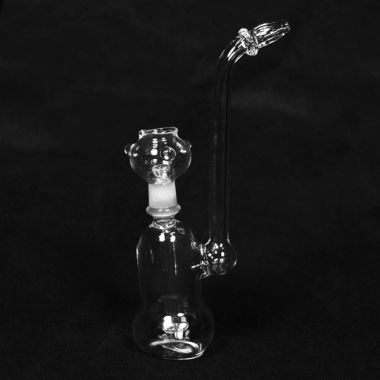Order by 3:30pm Mon-Fri for same-day dispatch
Call 0208 293 9231 to Order & Collect
- Online Enquiries 0208 293 9231
Dab Rigs
If you're searching for your first rig or looking to add a new piece to your collection, you've come to the right place. All our glass pieces are crafted with meticulous attention to detail and quality. We offer a wide range of designs in every conceivable shape and size, allowing you to select the perfect bong with confidence!
20 products
 Mini Honeycomb Glass Oil RigFrom £22.99
Mini Honeycomb Glass Oil RigFrom £22.99The Mini Honeycomb Glass Oil Rig is a cool looking gadget that will get you the job done at a very low cost!
- 20% Off
 Jaxx USA 'Frankie Costello' 38cm Bong/Oil Rig£95.99Free UK Delivery
Jaxx USA 'Frankie Costello' 38cm Bong/Oil Rig£95.99Free UK DeliveryThe Jaxx USA 'Frankie Costello' is one of the greatest 3 chamber recycler bongs on the market right now. Named after the legendary Italian-American Mafia boss, the 'Frankie Costello' is the perfect recycler for either beginners or experts alike.
 Rasta Oil Bubbler£19.99+ A free Quartz Bulldozer Banger & Carb Cap
Rasta Oil Bubbler£19.99+ A free Quartz Bulldozer Banger & Carb Cap The Rasta Oil Bubbler is a serviceable device that will allow you to dab with style!
 Rasta Zigzag Oil Bubbler£19.99
Rasta Zigzag Oil Bubbler£19.99The Rasta Zigzag Oil Bubbler is a 3 piece device consisting of a glass, dome and as well as the oil bubbler body.
 Red Herringbone Dab Rig£19.99
Red Herringbone Dab Rig£19.99The Red Herringbone Dab Rig is a fantastic piece of glassware that will get you covered whenever you fancy a classy dab!
 Steamy Mini Oil Bubbler£18.99
Steamy Mini Oil Bubbler£18.99The Steamy Mini Oil Bubbler is a nice looking and comfortable device that resembles a bunch of old steam powered pipes!
 Stropharia Glass Oil Bubbler£21.99
Stropharia Glass Oil Bubbler£21.99The Stropharia Glass Oil Bubbler is a nice looking gadget that has been provided with a very organic shroomish appearance that is sure to delight you and enlighten you!
- 20% Off
 Cheeky One Isotrope Glass BongFrom £19.99Free UK Delivery
Cheeky One Isotrope Glass BongFrom £19.99Free UK DeliveryThe Cheeky One Isotrope Glass Bong is a new addition from the Cheeky One Sci-Fi range
 Chongz 10cm 'Chucky' Glass Oil Rig£23.99
Chongz 10cm 'Chucky' Glass Oil Rig£23.99The Chongz 10cm 'Chucky' Glass Oil Rig is a real miniature flavour savour, perfect for tasting those subtle flavour profiles in your favourite concentrates.
 Chongz 29cm 'Brassneck' Oil Rig£54.99Free UK Delivery
Chongz 29cm 'Brassneck' Oil Rig£54.99Free UK DeliveryOne of the most functional and clean pieces in the Chongz artillery is the 'Brassneck' Oil Rig.
- 35% Off
 Glass Oil Bubbler with Dome£14.99Special
Glass Oil Bubbler with Dome£14.99SpecialThe Glass Oil Bubbler with Dome is an awesome little bubbler designed specifically for use with oils and wax. Perfect for personal use or passing around.
- 29% Off
 Dab Lab Dabboo Oil Rig£24.99Special
Dab Lab Dabboo Oil Rig£24.99SpecialHere is another affordable, functional rig from Dab Lab, introducing the Dabboo!
 Dab Labs Reactor Core Banger Beaker£29.99
Dab Labs Reactor Core Banger Beaker£29.99With the DAB LAB Reactor Core Banger Beaker it just cannot get any better!
 Chongz 'Sickly Child' 17cm Glass Oil Rig£22.99Free UK Delivery
Chongz 'Sickly Child' 17cm Glass Oil Rig£22.99Free UK DeliveryThe Chongz 'Sickly Child' Is a reasonably priced high quality glass dab rig from the trustful brand Chongz.
 Quartz Banger Beaker Oil Rig£24.99
Quartz Banger Beaker Oil Rig£24.99This Quartz Banger Beaker Oil Rig is made completely from Quartz! That means it is super strong and heat resistant! Just what you want from a dab rig!
 18.8mm Nectar Collector Kit£35.99Special
18.8mm Nectar Collector Kit£35.99SpecialNectar Collector's are a really cool and diverse way for you to enjoy your favourite concentrates. Dose your dabs perfectly without using any excess, and enjoy them in a unique way.
 Dab Lab 'Centrifuge' Quartz Banger Beaker£29.99Out of StockFree UK Delivery
Dab Lab 'Centrifuge' Quartz Banger Beaker£29.99Out of StockFree UK DeliveryCompact Quartz Banger Beaker by Dab Lab. Featuring centrifuge quartz balls which swirl beneath a riptide carb cap to deliver the best functioning rig in the Dab Lab beaker range.



